Slab Climbing: 5 Drills to Get Better (2024 Guide)
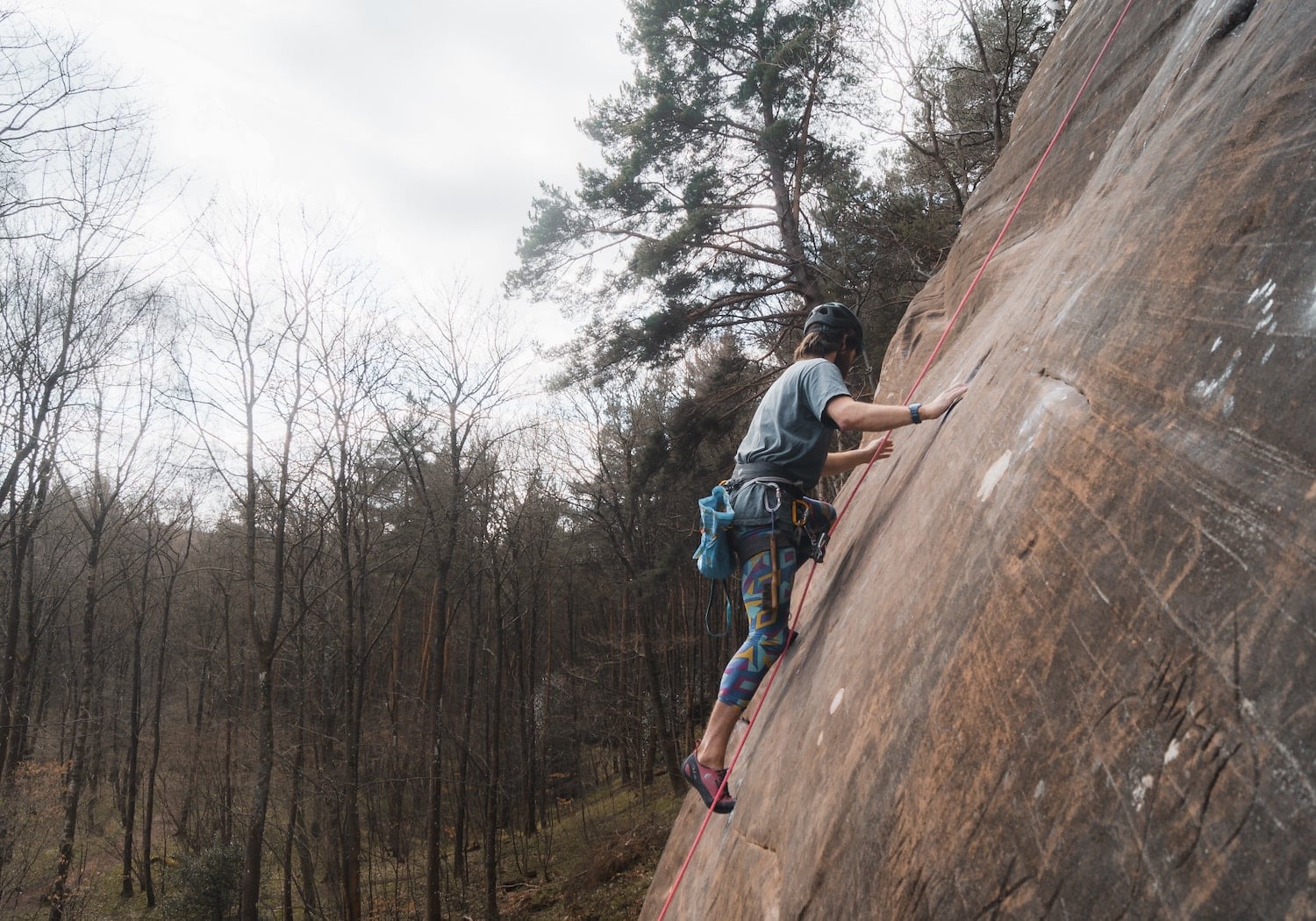
Published on: 09/22/2023
If you want to become a good all-around rock climber, you’ll have to master the slab. Many rock climbers avoid this technical and sometimes scary form of climbing, but slab climbing skills are necessary for everything from big wall trad to single pitch sport climbing to comp-style boulders in the gym.
What Is Slab Climbing?
Slab climbing refers to rock climbing where the angle of the wall is less than vertical. In contrast to overhung or steep vertical climbs where lots of upper body pulling is required, when slab climbing the climber needs to stand on their feet and utilize good slab climbing technique.
Unique challenges of slab
Many beginners find slab climbs tricky. To excel, you’ll need good footwork and an understanding of body position and balance.
Slab climbing can feel difficult is because it can be intimidating, especially outdoors. It’s not necessarily more dangerous than other types of rock climbing, but there is potential for getting a bit scraped up. When you fall off of an overhung sport route, you’re falling straight down into space. But when falling on slab climbs, especially if you fall high above your bolt, you might scrape against the wall a bit– this is commonly referred to as “cheese grating”. To fall safely, keep your chest and hands away from the wall and slide your feet along the rock face.
Even if you don’t want to become an expert slab climber, you’ll probably encounter it at some point. Many traditional climbs, sport routes, and even outdoor boulders have sections of slab climbing, so it’s important to know how to climb this type of terrain.
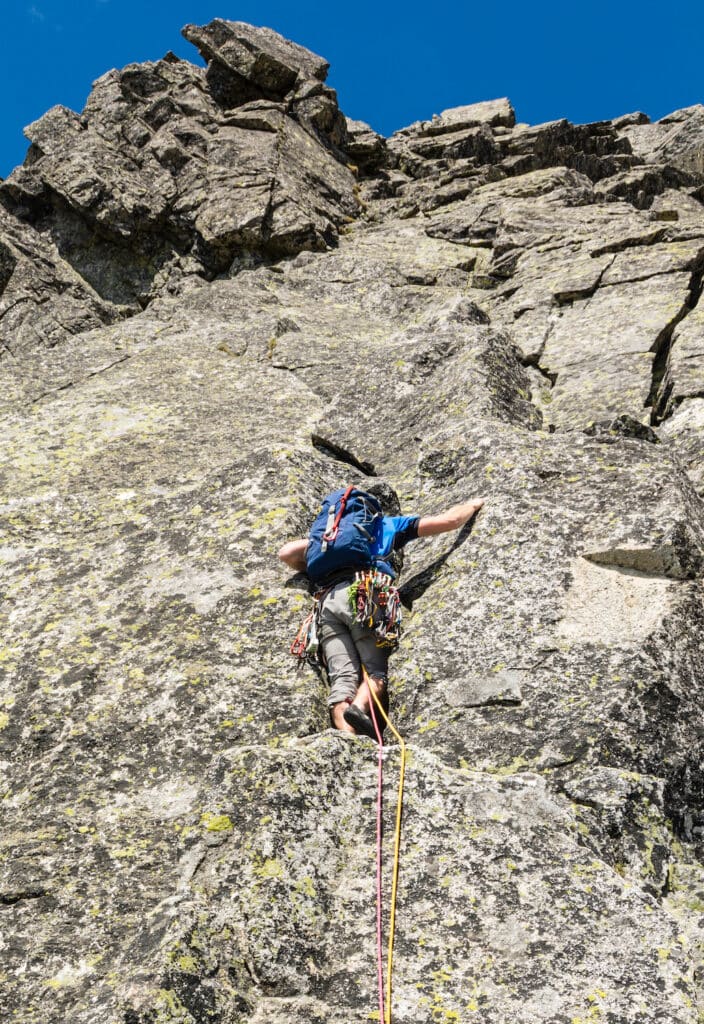
Slab Climbing Techniques
Climbers who excel at slab climbing focus on technique. Knowing just a few key strategies can unlock climbs that would otherwise feel impossible!
Slab climbing often lacks big holds, so you’ll want to keep your weight on your feet as much as possible. If the rock has features like edges or knobs, these can make great footholds. Since the rock is low angle, even a tiny edge can make a great foothold if you utilize precise foot placement and maintain balance.
The hand holds will be small too. You may need to utilize a full crimp often when slab climbing, as this will give you the most purchase on small holds. If the rock wall has little cracks, try using one as a handhold!
Slab climbing requires a good understanding of body positioning and movement. One principle to keep in mind is “nose over toes”. If you’re leaning too far back or too far forward, you’re likely to slip. Instead, keeping your nose over your toes will balance your center of gravity and help you maintain stability.
Having good core strength is important for slab climbing– engaging your core will help you maintain body tension. In general, try to keep your feet shoulder width apart and take small steps, as this will give you more control.
5 Drills to Get Better at Slab Climbing
1. No hands climbing
You can do this drill on boulder problems or on a top rope. Pick easy climbs and do them without hands! This will help you learn to create tension and place more weight on your feet. You can also make your hands into fists so that you can’t actually grab holds but you can still use your hands to help you balance. Another variation is to climb with only one hand. For some inspiration, check out videos of crazy no-hands ascents from slab expert Johnny Dawes!
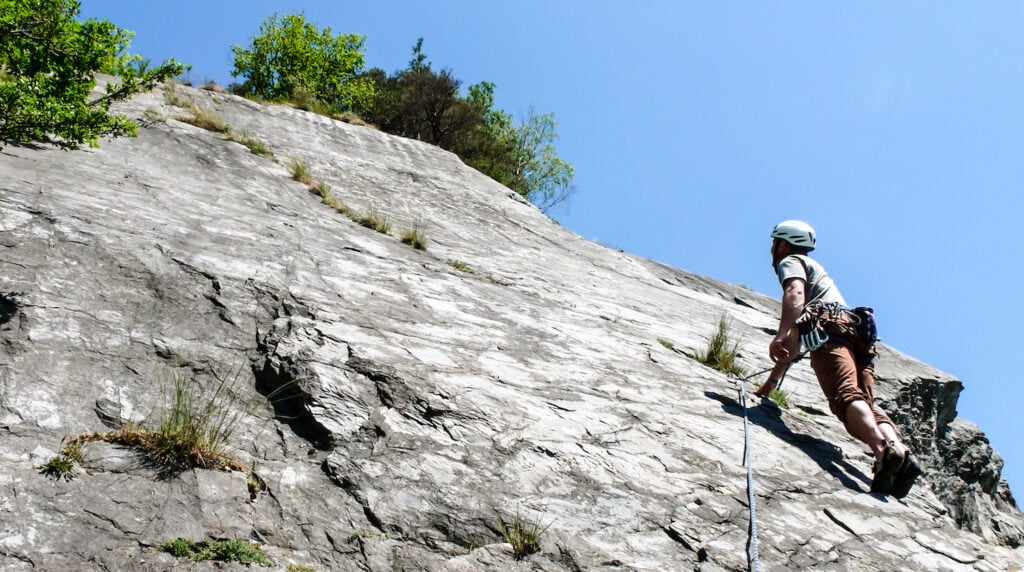
If this feels challenging, try to incorporate more smearing. Smearing refers to using smooth rock as a foothold by orienting your foot perpendicular to the wall and dropping your heels low. Try to stand on the balls of your feet to maximize the surface area of your shoe’s sticky rubber that is in contact with the rock. When you are climbing a slab using only smooth rock instead of textured holds, this is called friction climbing!
Manipulate your center of gravity and play with the different angles of your body. Lean forward so you have your nose touching the wall, then lean back. Experiment to see what keeps you from sliding off the wall.
2. Down climbing
Down climbing can help you improve your body awareness and become more familiar with the techniques and positions used in slab climbing. This is another drill that can be done on boulder problems or top rope routes– just find a slab that’s relatively easy for you so that you will be able to down climb it. Climb up, then back down! As you climb, be mindful of each foot placement and how your body moves.
This drill is also a good opportunity to practice resting. Many slab climbers find that their toes (especially the big toe!) get tired and their calves get pumped when climbing long sections of slab. So instead of shaking out your arms, try shaking out your legs! If you have a decent foothold, shake out each calf in turn to increase your slab stamina.
Another technique you can use is to rest on your heels in order to give your toes and calves a break. If the slab you are climbing has some ledges or larger holds, try turning your foot sideways and standing on your heel for a bit before making your next move. This will take pressure off your toes and allow them to recover before you continue up the wall.
3. Create a new route
A great way to gain a better understanding of the technical aspects of climbing slab is to create your own slab climb. You don’t need to be a route setter to do this drill– just head to the slab wall at your local bouldering gym. Instead of climbing the pre-set problems, design your own slab climb by using holds from various climbs.
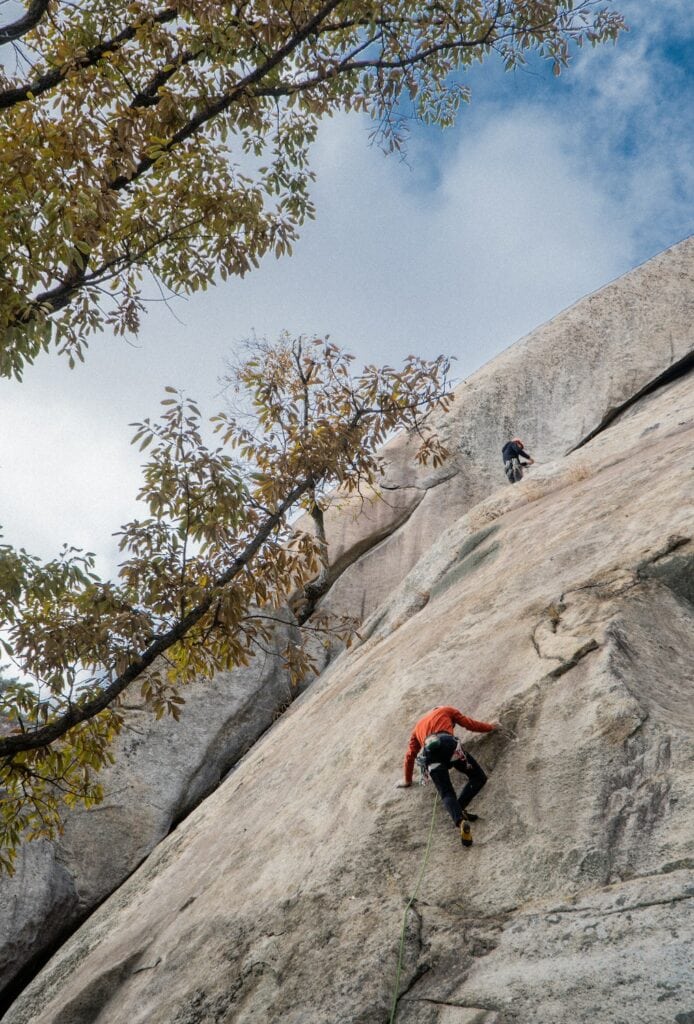
Try to incorporate common slab techniques, like palm pressing and smearing. A palm press is sort of like smearing with your hands. This technique is performed by pushing on rounded rock and relies heavily on surface area and friction. To execute this technique, you’ll place your palm on the surface of the rock or plastic somewhere below your chest with your fingers pointing down. You then press into your hand in order to generate upward momentum.
Features like dips or dishes are good places to utilize smears or palm presses. Try to find the lowest-angle part of the wall to smear or push on. This will give your foot or hand the maximum contact surface.
4. One foot on
Good slab climbers trust their feet. Footholds that would be useless on overhangs may work quite well on low angle rock. The tip that has helped me the most in my slab climbing is when you step up onto a foothold, commit to it fully. Especially if you’re scared, it’s easy to halfheartedly step up on a foothold. Instead, try climbing slab “feet-first”: lead by confidently stepping up instead of pulling up with your muscles.
A good way to practice trusting your feet is to have only one foot on the wall at a time. This isn’t how you should climb hard slabs, but it can give you a sense of what it feels like to fully step up on each foot. To perform this drill, climb an easy slab with one foot flagging at all times– don’t ever stand with both feet on holds. For example, start with your left foot on a hold. As you step your right foot onto the next hold, immediately switch the left foot to flagging so your weight is fully on your right.
5. An off the rock drill
If you have slab goals, try incorporating some specific exercises that target strength and flexibility. High stepping can be useful on slabs, as there tend to be limited footholds. In general, taking small steps will help you stay upright. However, if the only available foothold is up by your waist, you might be stuck if you are unable to perform a step up to the hold. To improve your high steps, do stretches like the pigeon pose and sideways splits to increase your flexibility and hip mobility.

To improve your ability to step up onto your feet, you’ll need strong legs. You can train this motion by performing step-ups onto a box or high step while holding a weight with both of your hands. Simply step up onto onto one leg ten times on each side, and then switch sides. Start with doing two sets of 10 reps, with a weight that feels challenging but not imposssible.
Slab Climbing Shoes
The right climbing shoes will help you create friction on the wall when you’re slab climbing hard. Stick with a flat shoe for slab climbing, as this will allow you to get more rubber in contact with the rock when smearing.
Stiff shoes are better for edging, but soft shoes excel when you need to smear. So this decision might depend on what kind of slab you are doing. If there’s lots of little crystals to stand on, a stiff shoe might work better. If it’s a pure friction slab, you want a soft shoe so you can maximize the amount of rubber that touches the rock.
Here are some recommendations so that you can choose the right shoes:
- Las Sportiva TC Pro: Loved by trad and slab climbers alike, this shoe is amazing at vertical edging and decent at smearing (probably not the top pick for a pure friction route).
- Five Ten NIAD/Anasazi VCS: The NIAD VCS has sticky rubber with good friction, which gives you excellent purchase on the rock. These shoes excel in smearing and perform well on small nubs, too.
- Five Ten Mocasym: Climbers have loved the Mocasym for years. This is a super soft model– one of the best slab climbing shoes for pure friction climbing.
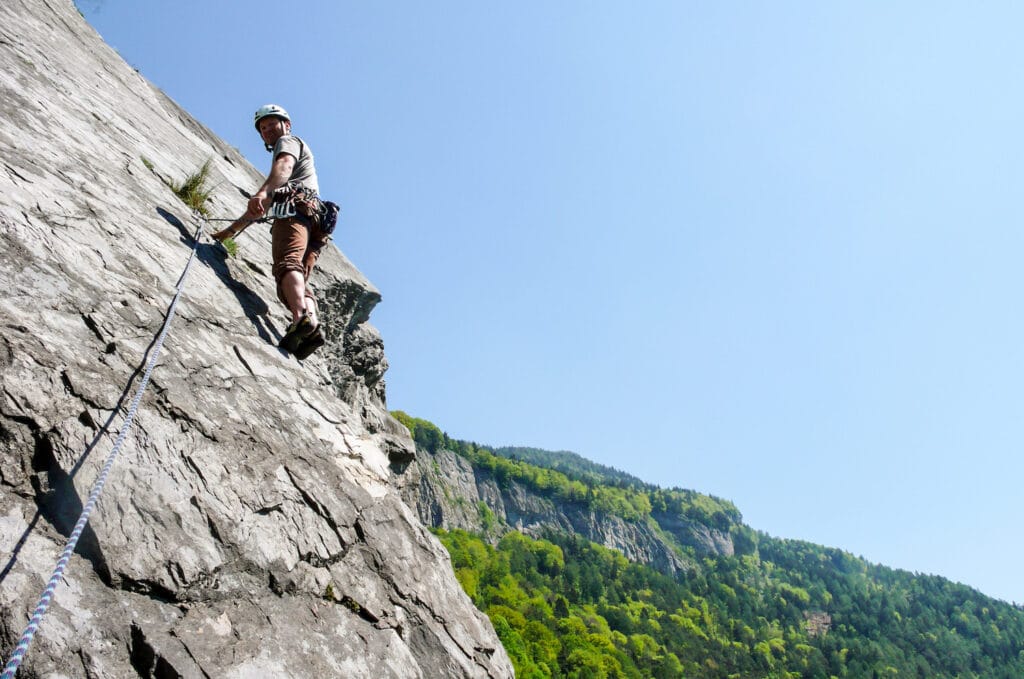
Slab Climbing Spots
If you enjoy slab climbing or want to practice this skill, there are some great areas to visit. Some top options include:
Yosemite
In addition to lots of cracks, Yosemite has many famous bolted slab routes as well as some slab boulders. There’s plenty of harder routes, including some that are somewhat dangerous.
Alabama Hills
This California sport climbing destination has many slab climbs, and almost all of the routes are 5.10 or easier.
Looking Glass Mountain
A North Carolina multipitch climbing destination with lots of easier slab climbs, including routes in the 5.5 to 5.8 range.
Slab climbing is a highly technical form of rock climbing. You’ll need to push, use good footwork, and find the correct position in order to excel. Using the drills in this article will help you become a better slab climber, whether you are climbing pure friction slab or a nearly vertical wall.
